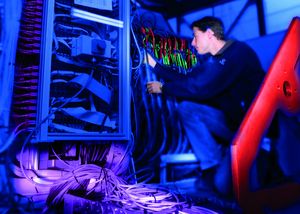Detector development – highly granular calorimeters
The group’s detector activities concentrate on the development of hadronic calorimeters, whose purpose is to measure particle showers with unprecedented spatial granularity. They are therefore known as “imaging calorimeters” as well. The work is undertaken in the CALICE collaboration, where we are working on the analog hadronic calorimeter (AHCAL).
Technical background to the detector development
The AHCAL uses small plastic scintillator tiles which are read out individually by silicon-based light detectors (silicon photomultipliers, SiPM). The calorimeter records high-resolution three-dimensional images of each particle shower. This allows modern techniques to be used for the event reconstruction, for example “particle flow” algorithms which promise to significantly improve the energy measurements at linear colliders compared to current technology. The high granularity also provides the necessary information for advanced methods of determining the energy of individual particles that are being developed in the MPP group.
In recent years, these new technologies have been tried out in test experiments at accelerators with a first prototype measuring 1 m3 and weighing 8 tons. Detailed information on the physics of these particle showers was gained by the three-dimensional analysis of hadronic showers, leading to an improvement in the simulations of particle detectors and thus being of great importance for other experiments in particle physics.
The focus has meanwhile shifted to the development of “technological” prototypes. Over the next few years, these detectors will demonstrate the abilities of highly granular calorimeters under realistic conditions with compact electronics completely integrated in the detector. The technologies developed within CALICE are also used in other projects, from the upgrades of the LHC detectors to systems in medical diagnostics.
